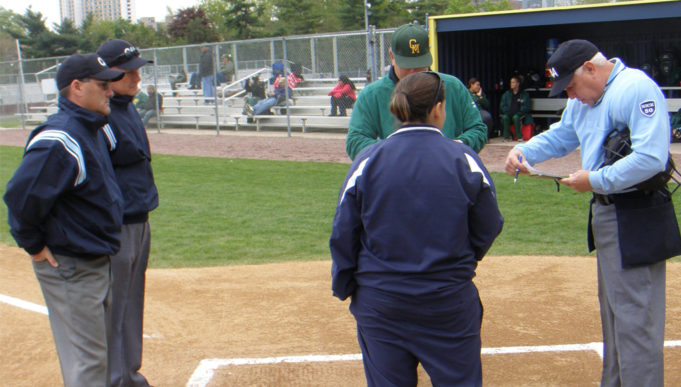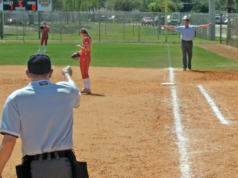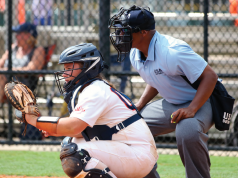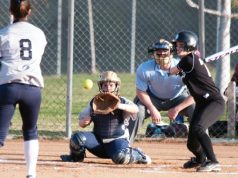By Rick Woelfel
Watching an NCAA Division I crew at work is akin to attending an umpiring seminar. I was afforded that opportunity in late April when Drexel hosted Colonial Athletic Association (CAA) rival George Mason in a three-game weekend series.
The presenters were Gary Yost, Joe McGeever and John Bradbury, all veteran college umpires with some six decades of collegiate experience among them. Yost has been to two Division I regionals, Bradbury to one.
The crew offered practical lessons that would benefit any umpire, regardless of experience.
Preparedness prevents problems.
During its pregame meeting, the crew focused on its rotations and fly-ball coverages. They don’t want to go into the outfield unless it’s necessary.
“We want to have that advantage (of three sets of eyes in the infield) as often as we can,” Yost says. “We’ll stay in as often as we can. On deep shots to the outfield you’re going to have multiple bases being touched. So the more eyes we have on that in the infield, the better off we are.”
It is a particularly important series for Drexel, which is contending for a bid in the CAA postseason tournament. The crew briefly discusses the various playoff scenarios before taking the field, where they check the bats of both teams to verify they are legal; the NCAA requires the process be repeated before the second game of the doubleheader as well.
The third team on the field.
Yost, Philadelphia, is the crew chief and has the plate for the first game with McGeever, West Deptford, N.J., at first and Bradbury, Philadelphia, at third.
With one out and the bases empty in the home second, a Drexel player, batting left-handed, lays down a drag bunt along the first-base line. The ball deflects off her front foot. Yost has primary responsibility for the call, but he’s screened by the catcher popping up in front of him. McGeever kills the ball while Bradbury echoes the dead-ball signal. The crew huddles at the edge of the circle and determines the batter was out of the batter’s box.
After Yost signals the out call the Drexel coach questions whether the ball was fair and the crew huddles again. Bradbury confirms that it was indeed a fair ball and Yost again indicates the batter is out.
Throughout the situation and throughout the weekend, the umpires project an image of solidarity. They provide honest feedback to one another, but it’s clear they’re a cohesive unit.
Communication counts.
McGeever moves behind the plate for game two, with Bradbury shifting to first and Yost to third.
As was the case in the opener, complaints about balls and strikes are virtually non-existent. McGeever makes sure, however, to keep the lines of communication open with the George Mason catcher working in front of him. The two hold a brief conversation after the home first.
“I called one pitch on the corner a strike,” McGeever says. “The next pitch was a little farther outside (for a ball).” She yelled out to her pitcher ‘You just missed it.’ So she kind of knew what I was doing. (Catchers) ask more questions at the beginning than they do at the end. They kind of see what you’re doing.”
At one point McGeever gets help on a swipe-tag play along the first-base line. The George Mason first baseman thought she made a tag, but McGeever makes no signal.
Upon request from the George Mason coach, he goes to his partner for assistance; Bradbury, working near second base, indicates there was no tag.
Yost has a close play of his own on a steal at second base when the runner beats the throw but overslides. Yost stays with it and correctly calls her out.
The two teams leave the field with a doubleheader split.
One pitch, one play at a time.
Bradbury has the plate for the series finale on Sunday. Yost is at first while Tim Gallagher, another veteran umpire, replaces McGeever (not available on this day) at third.
Bradbury finds he’s having to work extra hard on balls and strikes. At one point he calls a high strike on a Drexel batter and the coach gives him a verbal blast.
“You know when you miss a pitch high or low,” Bradbury says. “I asked Gary (between innings) how it looked and he told me, ‘That was up.’
”When that happens you just have to take a deep breath and stay with every pitch.”
Meanwhile, Yost is having half a season’s worth of bang-bang plays at first base, or so it seems. At one point the George Mason coach pops out of the dugout to question a call. Yost meets him midway up the foul line.
“All I’ll do is answer direct questions,” Yost says. “I’ll take my (sunglasses) off, I know he’s coming, I’ll meet him halfway.
“He said, ‘What do you have?’ I said, ‘Well, clearly I have the runner beating the throw.’ He said, ‘Can you go for help?’ I said, ‘You know that’s not happening. It’s my call.’
“You live and die with it (but) on a close call, somebody’s not going to be happy with whatever word comes out of my mouth.”
It’s a short day for the crew; the game is called via the eight-run mercy rule after five innings with George Mason leading, 13-4. For the crew it’s a rather abrupt end to a weekend of challenges, great and small.
Sequel: Two days after the Drexel-George Mason series concluded, I was assigned to cover a high school game. Bradbury had the plate for what turned out to be a 1-0 nine-inning affair. He worked just as hard for the high school players as he had for the college players. That lesson may be the most important of all.
Rick Woelfel is a freelance writer and softball umpire from Philadelphia.
What's Your Call? Leave a Comment:
Note: This article is archival in nature. Rules, interpretations, mechanics, philosophies and other information may or may not be correct for the current year.
This article is the copyright of ©Referee Enterprises, Inc., and may not be republished in whole or in part online, in print or in any capacity without expressed written permission from Referee. The article is made available for educational use by individuals.



















